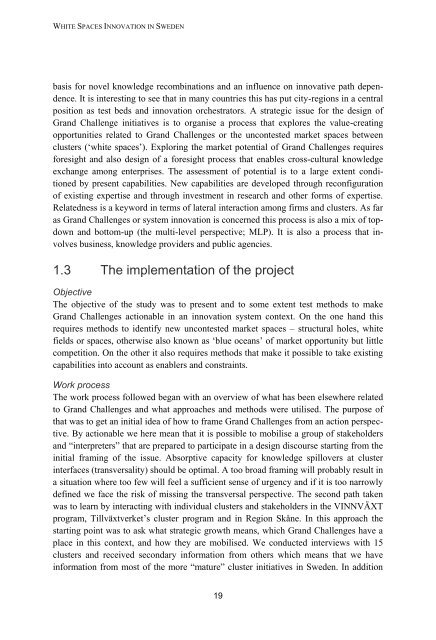White Spaces Innovation in Sweden - Innovation policy for ... - Vinnova
White Spaces Innovation in Sweden - Innovation policy for ... - Vinnova
White Spaces Innovation in Sweden - Innovation policy for ... - Vinnova
You also want an ePaper? Increase the reach of your titles
YUMPU automatically turns print PDFs into web optimized ePapers that Google loves.
WHITE SPACES INNOVATION IN SWEDENbasis <strong>for</strong> novel knowledge recomb<strong>in</strong>ations and an <strong>in</strong>fluence on <strong>in</strong>novative path dependence.It is <strong>in</strong>terest<strong>in</strong>g to see that <strong>in</strong> many countries this has put city-regions <strong>in</strong> a centralposition as test beds and <strong>in</strong>novation orchestrators. A strategic issue <strong>for</strong> the design ofGrand Challenge <strong>in</strong>itiatives is to organise a process that explores the value-creat<strong>in</strong>gopportunities related to Grand Challenges or the uncontested market spaces betweenclusters („white spaces‟). Explor<strong>in</strong>g the market potential of Grand Challenges requires<strong>for</strong>esight and also design of a <strong>for</strong>esight process that enables cross-cultural knowledgeexchange among enterprises. The assessment of potential is to a large extent conditionedby present capabilities. New capabilities are developed through reconfigurationof exist<strong>in</strong>g expertise and through <strong>in</strong>vestment <strong>in</strong> research and other <strong>for</strong>ms of expertise.Relatedness is a keyword <strong>in</strong> terms of lateral <strong>in</strong>teraction among firms and clusters. As faras Grand Challenges or system <strong>in</strong>novation is concerned this process is also a mix of topdownand bottom-up (the multi-level perspective; MLP). It is also a process that <strong>in</strong>volvesbus<strong>in</strong>ess, knowledge providers and public agencies.1.3 The implementation of the projectObjectiveThe objective of the study was to present and to some extent test methods to makeGrand Challenges actionable <strong>in</strong> an <strong>in</strong>novation system context. On the one hand thisrequires methods to identify new uncontested market spaces – structural holes, whitefields or spaces, otherwise also known as „blue oceans‟ of market opportunity but littlecompetition. On the other it also requires methods that make it possible to take exist<strong>in</strong>gcapabilities <strong>in</strong>to account as enablers and constra<strong>in</strong>ts.Work processThe work process followed began with an overview of what has been elsewhere relatedto Grand Challenges and what approaches and methods were utilised. The purpose ofthat was to get an <strong>in</strong>itial idea of how to frame Grand Challenges from an action perspective.By actionable we here mean that it is possible to mobilise a group of stakeholdersand “<strong>in</strong>terpreters” that are prepared to participate <strong>in</strong> a design discourse start<strong>in</strong>g from the<strong>in</strong>itial fram<strong>in</strong>g of the issue. Absorptive capacity <strong>for</strong> knowledge spillovers at cluster<strong>in</strong>terfaces (transversality) should be optimal. A too broad fram<strong>in</strong>g will probably result <strong>in</strong>a situation where too few will feel a sufficient sense of urgency and if it is too narrowlydef<strong>in</strong>ed we face the risk of miss<strong>in</strong>g the transversal perspective. The second path takenwas to learn by <strong>in</strong>teract<strong>in</strong>g with <strong>in</strong>dividual clusters and stakeholders <strong>in</strong> the VINNVÄXTprogram, Tillväxtverket‟s cluster program and <strong>in</strong> Region Skåne. In this approach thestart<strong>in</strong>g po<strong>in</strong>t was to ask what strategic growth means, which Grand Challenges have aplace <strong>in</strong> this context, and how they are mobilised. We conducted <strong>in</strong>terviews with 15clusters and received secondary <strong>in</strong><strong>for</strong>mation from others which means that we have<strong>in</strong><strong>for</strong>mation from most of the more “mature” cluster <strong>in</strong>itiatives <strong>in</strong> <strong>Sweden</strong>. In addition19
















